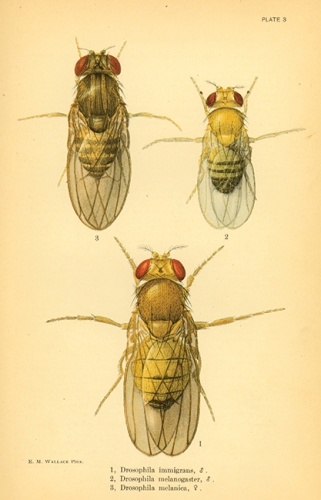In 1921, the fruit fly Drosophila melanogaster was becoming the lab animal of choice for scientists studying heredity. Geneticist Alfred Sturtevant decided to write a comprehensive review of North American species of Drosophila. He included just about everything a scientist from that era could observe about the little flies. Descriptions of the mating rituals of nineteen different species. The relative lengths of the joints of their legs. What he had successfully fed Drosophila immigrans (banana, pineapple, apple, tomato, sour boiled potato, bran mash, and graham-flour paste). These drawings by Edith M. Wallace were some of the earliest detailed color images of Drosophila to circulate among scientists. For scientists hunting mutations that could help them map a chromosome or discover how genes influence each other, the tiniest variations in a fly’s appearance could be important scientific clues. This image is from The North American Species of Drosophila by Alfred H. Sturtevant, with drawings by Edith M. Wallace. It was published in 1921 by the Carnegie Institution of Washington (now the Carnegie Institution for Science). A copy of the book can be found in UNC-Chapel Hill’s Biology/Chemistry Library.


